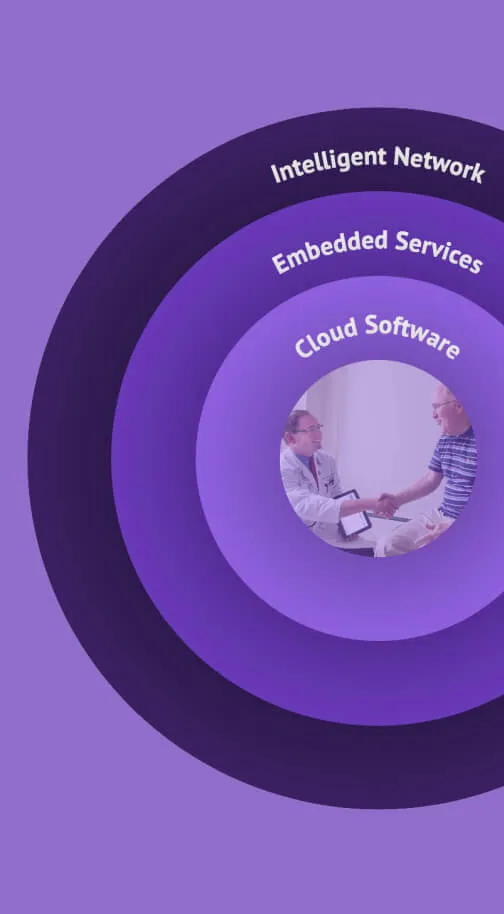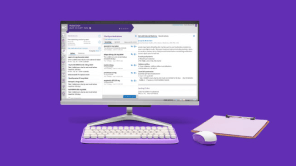athenaOne® empowers orthopedic practices to overcome specialty challenges
Practicing orthopedics today requires a special set of skills. With the high patient volumes they see, orthopedists need speed to pivot quickly from one patient to the next. They also need flexibility to navigate the complex billing requirements of their specialty. And they need agility to stay financially viable in the face of rising costs and declining reimbursements from Medicare and private insurers.
It’s a complex playing field—but the right technology can help orthopedic practices retain their competitive edge. Efficient, specialized orthopedic EHR and revenue cycle management software can help reduce the administrative burdens of orthopedic practice while improving clinical and operational workflows alike.
athenaOne® for Orthopedics is designed to help orthopedists face industry obstacles head-on. Because we understand the key challenges in orthopedic care, we’ve designed the tools and support that orthopedic practices need to thrive in a uniquely demanding—and rewarding—healthcare environment.
Addressing key obstacles in orthopedic care
Recognizing the challenges the industry presents to orthopedic clinicians is the first step in overcoming them. These six pain points are common to orthopedic practices of every size.
1. Managing high patient volumes efficiently
Two factors contribute to the typically high-volume, fast-paced business of orthopedics. For one, unlike front-door medical fields such as internal medicine, family medicine, and pediatrics which see the same patient multiple times over many years of care, many orthopedic patients visit an orthopedist for help with a single, focused incident. Without the “guaranteed” repeat business that other types of practices see, orthopedic clinicians need to maintain a high throughput of patients to remain viable. Each of those patients must have correct and complete documentation completed in the orthopedic EMR. The faster and more intuitive the tools for documentation, the more agile the orthopedist can be.
Another factor is the diverse number of clinical settings where orthopedists meet patients. Many orthopedists practice at multiple care locations, such as an ASC, a hospital, and their own practice or clinic. They’re responsible for quick checkups on post-surgery patients, and they field lots of referrals. So their patient panel is necessarily large, with workloads to match the demand.
2. Navigating complex billing processes
Orthopedic billing is notoriously complex. Beyond traditional government and commercial payers, orthopedists may be billing for Worker’s Compensation, Motor Vehicle Accidents (MVA), and legal contracts. In addition, the various care settings where orthopedists practice may have their own billing processes, adding complexity. Because different payers have their own pre-authorization requirements for different procedures, it adds up to an intricate system of billing rules and regulations which must be expertly navigated for the orthopedist to receive what they’re owed in a timely way.
3. Mitigating financial pressures
Medical practices across all specialties must keep a close eye on financial sustainability, and orthopedic practices are no exception. They’re feeling the pinch of declining reimbursement rates year over year: in calendar year 2025, the average decrease in Medicare payment rates is 2.93%.1
Orthopedic practices are also facing the anticipated shortage of orthopedic surgeons forecast by the Health Resources and Services Administration (HRSA). With high demand for each new orthopedic clinician graduating from medical school, practices will have to offer competitive salary and benefit packages to attract and retain them.
As more orthopedists take on value-based care models such as bundled payments, another source of financial pressure arises: delivering comprehensive care without exceeding the amount they’ve been paid to deliver it. Bundled payments incentivize providers to manage the cost of care.
4. Staying competitive in a fast-growing market
A bright spot for orthopedic specialists is that the demand for their services is on the rise. The challenge here is in finding ways to stand out in an increasingly crowded field. How crowded? The orthopedic market grew 6.5% in 2023, reaching $59 billion globally,2 with large joint surgical volumes driving much of the U.S. market expansion. In addition, the rising availability of robotics and other technologies, expanded access to orthopedic Ambulatory Surgery Centers (ASCs), and increased patient flexibility due to remote work have made procedures more accessible.
As orthopedic care moves out of the hospital and into ASCs, more orthopedic practices are operating their own ASCs to remain independent and financially strong. As of 2024, 52% of ASCs in the U.S. were physician-owned.3 Since 2010, orthopedic procedures performed in ASCs have increased by more than 50%, significantly outpacing growth in hospital outpatient departments.4
To successfully deliver care across multiple settings, orthopedists need software, tools, and technology that offer friction-free care coordination, efficient data exchange, and adaptable workflows.
5. Reducing administrative burden
The increasing complexity of healthcare regulations is high on the list of orthopedic challenges. According to the 2023 Medscape Physician Compensation Report, orthopedists reported spending an average of 52.9 hours per week at work, 14 of which were spent on paperwork and administration.5
athenahealth’s 2025 Physician Sentiment Survey confirms that orthopedists and other specialists are weighed down by administrative burden. When asked, 75% of specialists said a significant portion of their time is dedicated to non-reimbursable tasks; and 58% said they feel overwhelmed by administrative requirements and burdens once a week or more. Nine out of ten physicians (91%) said the burden of regulatory requirements is getting worse.6
6. Supporting multi-site procedure management
Orthopedic clinicians don’t typically work from one single location. Their fast-paced work week might include patient encounters at their practice, surgery days with several procedures in a row, visits to patients in the hospital and/or emergency department and traveling to other clinics. To successfully deliver care across these multiple settings, they need orthopedic EHR software, tools, and technology that offer friction-free care coordination, efficient data exchange, and adaptable workflows.
The athenaOne advantage for orthopedic practices
From the clinical workflow to the patient experience to revenue cycle expertise, athenaOne for Orthopedics restores function and flexibility so orthopedists can deliver excellent patient care.
1. Efficiency across care settings – work the way you work, wherever you work
athenaOne for Orthopedics optimizes clinical and operational efficiency with tailorable, ortho-specific workflows that surface the right information at the right time, in the moment of care. As an orthopedic EHR, athenaOne’s orthopedic-specific documentation accelerators and customizable clinical content can trim valuable time off patient charting. The experience is intuitive and efficient so orthopedic clinicians can give more of their attention to the patient, not the screen.
athenaOne’s orthopedic EMR software supports this with a mobile-friendly platform, voice-enabled documentation, AI-driven ambient listening, and integrated scribe functionalities. These features enable quick and accurate clinical documentation that requires much less typing, allowing orthopedists to focus more on patient care and less on administrative tasks.
2. Financial performance optimization
athenaOne’s streamlined billing workflows and robust, comprehensive reporting capabilities help orthopedic practices optimize financial performance, reduce denials, and improve revenue cycle efficiency. athenaOne simplifies the complexity of reimbursement with billing automation, real-time claims management, and prior authorization management built into the orthopedic practice management software. These features support faster reimbursements and reduced billing errors.
Clinicians using athenaOne for Orthopedics have our subject matter experts on their side, too. With highly skilled orthopedic-specific onboarding and Customer Success teams, practices are enabled to thrive from day one.
3. Consumer-grade patient engagement
Today’s patients expect their interactions with their orthopedic clinicians to be as intuitive and simple as buying shoes online or requesting a ride on their mobile phone. athenaOne for Orthopedics provides the friction-free digital experiences patients prefer, such as self check-in, a mobile-friendly patient portal, and automated appointment reminders that put them at the center of their care.
Just as important as the clinical experience for patients is the financial one. Knowing that medical costs are on everyone’s minds, athenaOne makes it easier for patients to understand and pay their share of the bill. Its orthopedic patient engagement software includes balance notifications, payment plans, and self-pay out-of-pocket cost estimates so they can plan for the cost of care.
4. Comprehensive data analytics and reporting
Every orthopedic practice cares deeply about its performance. athenaOne for Orthopedics has the tools to help them thrive. From real-time analytics to financial data views to the ability to consolidate multiple data sources into a single reporting system, athenaOne empowers orthopedic practices with actionable insights to drive informed decision-making. Benchmarking is made possible with insights from the largest connected network in healthcare, so orthopedic clinicians can satisfy their competitive streak and see how their performance measures up in comparison with their peers.
5. Efficient data integration and interoperability
Working in multiple care settings as they do, and receiving and making countless referrals, orthopedists need data integration and interoperability they can count on. The athenaOne network integrates effortlessly with major hospital systems, key orthopedic vendors, imaging centers, labs, referral networks, and others through our connections with CommonWell and TEFCA, so clinicians can access the information they need to provide informed patient care.
Additionally, athenaOne recently introduced ChartSync, which currently integrates external medication fill history directly into athenaOne’s orthopedic EHR software. Future releases of ChartSync will integrate external lab results, imaging, and vaccines into athenaOne, giving clinicians a more complete picture of the patient’s medical history from external sources.
6. Designed for independent, high-performing orthopedic practices
Orthopedic surgeons are highly competitive, financially driven, and deeply specialized. They value efficiency and innovation, leveraging scribes, dictation, and mobile solutions to minimize hands-on interactions with the EHR. To support their need for speed, accuracy, and the insights to thrive, this EHR for orthopedics offers:
- Orthopedics-specific workflows at no additional cost
- Customizable solutions to serve highly specialized practices
- A mobile EHR app that allows them to complete many clinical tasks anytime, anywhere
- Dedicated onboarding and Customer Success teams with orthopedic expertise
- Tight-knit user groups for orthopedics, physical therapy, pain management, ASCs, and more to share best practices and stay ahead of the competition
7. Simple pricing model and scalability
With our transparent pricing structure, orthopedic clinicians can scale operations confidently while maintaining cost efficiency. What’s more, our dedicated Customer Success Managers meet with customers regularly to provide expertise and network-sourced best practices to help optimize financial performance, even as they scale and grow.
Run a more agile, flexible orthopedic practice with athenaOne
Orthopedic practices need a comprehensive orthopedic EHR and practice management solution that streamlines workflows, optimizes financial performance, and enhances patient engagement. athenaOne delivers all these benefits and more, equipping orthopedic clinicians with the tools they need to succeed while reducing administrative burdens.
Could your orthopedic practice use a lot more agility? We’re here to help. Get in touch to schedule a convenient demo of athenaOne for Orthopedics.
1. Centers for Medicare & Medicaid Services, Nov. 2024. Calendar Year (CY) 2025 Medicare Physician Fee Schedule Final Rule. Retrieved Mar. 24, 2025 from https://www.cms.gov/newsroom/fact-sheets/calendar-year-cy-2025-medicare-physician-fee-schedule-final-rule.
2. ORTHOWORLD (n.d.). The Numbers. Retrieved Mar. 24, 2025 from https://www.orthoworld.com/the-numbers/.
3. Surgical Information Systems, 2024. Ambulatory Surgery Center Statistics That Define the Industry. Retrieved Mar. 17, 2025 from https://blog.sisfirst.com/ambulatory-surgery-center-statistics-that-define-the-industry
4. Advantien, 2024. Orthopedic ASCs: 2024 Growth and Challenges. Retrieved Mar. 17, 2025 from https://advantien.com/orthopedic-ascs-2024-growth-challenges/
5. Kane, Leslie, Apr. 2023. Medscape Physician Compensation Report 2023: Your Income vs Your Peers’. Retrieved Mar. 24, 2025 from https://www.medscape.com/slideshow/2023-compensation-overview-6016341.
6. 2025 Physician Sentiment Survey of 1,001 physicians nationwide. Jan. 2025. Fielded by Harris Poll, sponsored by athenahealth.













